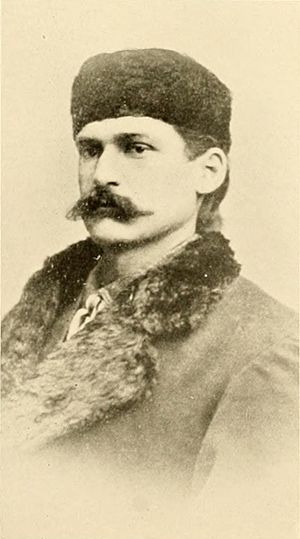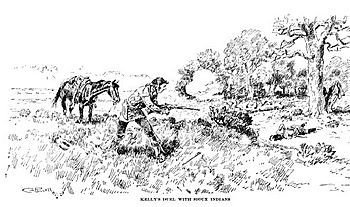Luther Kelly facts for kids
Luther Sage "Yellowstone" Kelly (born July 27, 1849 – died December 17, 1928) was a brave American soldier, hunter, and scout. He was also an adventurer and later worked in government. He fought briefly in the American Civil War. Later, he joined an expedition to Alaska in 1898. Kelly led a U.S. Army company during the Philippine–American War. After that, he worked in the government of the Philippines. Yellowstone Kelly was buried with military honors in Billings, Montana, overlooking the Yellowstone Valley.
Contents
Early Life and Army Dreams
Luther Sage Kelly was born on July 27, 1849, in Geneva, New York. His father owned a store. Luther's father passed away in 1857. This made Luther the man of the family at a young age. He went to school, but he really wanted to join the army. He wished he was old enough to fight in the Civil War.
Joining the Army
In the spring of 1865, the Civil War was ending. Kelly got permission from his mother to join the Army. He tried to join a cavalry unit in Rochester, New York. But he was only 15 and was turned away. Later, he joined the 10th Infantry by saying he was older. He didn't know this unit would keep serving after the war.
Kelly was sent to City Point, Virginia. After Robert E. Lee gave up at Appomattox, his group went to Richmond. Then they marched towards Washington, D.C.. Kelly's unit was part of a parade in Washington on June 8. This was his first important army duty.
His unit stayed in Washington for the summer. In November, they moved to St. Paul, Minnesota. They spent the winter at Fort Snelling. Later, his company moved to forts in the Dakota Territory. Kelly often hunted game to get fresh meat for his fellow soldiers. In April 1868, Kelly's time in the Army ended. He was discharged from Fort Ransom.
Adventures in the American West
After leaving the army, Kelly began a very adventurous time in his life. He became known as a great hunter, trapper, and scout in the American West. He first traveled to Fort Garry in Canada. He joined a group of miners there. He then traveled alone to the Missouri River. He reached Fort Buford in the winter.
Soon after arriving at Fort Buford, Kelly volunteered for a dangerous job. He offered to carry messages to Fort Stevenson, about fifty miles away. This route was very risky because of Sioux warriors. Mail carriers usually had a cavalry escort. But Kelly went alone. He reached Fort Stevenson safely.
On his way back, he stayed at the camp of Bloody Knife, an Arickaree chief. The next morning, two Sioux warriors attacked Kelly. One shot his horse. The other shot Kelly in the knee with an arrow. Kelly bravely shot and killed both attackers. He returned to Bloody Knife's camp to recover. After a few days, he rode back to Fort Buford. He became a local hero for his bravery.
Kelly explored the Judith Basin in Montana for many years. This was when conflicts with Native American tribes were increasing. He became famous as a hunter and scout. He hunted elk, buffalo, and antelope. In 1876, he rejoined the Army. He served as an important scout for General Crook. He helped Colonel Nelson Miles chase Sitting Bull and Crazy Horse.
Kelly stayed in the army after these conflicts. He scouted for Colonel Miles again. This time, he helped in the pursuit of Chief Joseph and the Nez Perce. After these duties, he returned to his ranch.
Alaska Expedition (1898)
The United States bought Alaska from Russia in 1867. But people didn't pay much attention to it until gold was found there in 1896. In 1898, the U.S. Army sent three groups to Alaska. Their job was to map a route from the Yukon and explore the Copper River Valley. Kelly joined one of these groups as a guide.
They left Seattle by ship on April 7, 1898. They arrived in Alaska about five days later. While they were getting ready, they heard that the Spanish–American War had started. One group was ordered to return. Kelly's group was told to continue their mission. Kelly was offered a special job as a captain in the U.S. Volunteers. He left Alaska on October 9. By the time Kelly got back to Seattle, the war was over.
The Army's trip to Alaska was not widely known because of the war. But it was very important. The route they mapped helped build the Alaska Railroad in 1923.
Fighting in the Philippines
In August 1899, Kelly became a captain again. This time, he joined the Army's 40th Volunteers. This was because Congress needed more soldiers. They needed to stop a rebellion in the Philippines. This war lasted three years.
Kelly's regiment left Fort Riley, Kansas, in November 1899. They sailed from California and arrived in the Philippines in late December. Kelly's company was led by Brigadier General James Bell. Bell had served with Kelly before. Kelly's company sailed to San Miguel Bay. From there, they marched inland to clear out rebels.
Kelly's company faced strong resistance near the town of LaLud. Rebels fired at Kelly's soldiers with two field guns. But Kelly's men managed to kill the enemy artillerymen and silence the guns. Kelly led a direct attack and defeated the rebels. During the fight, Kelly captured the ceremonial Spanish sword of the rebel leader, Colonel Legaspi.
Kelly later worked for the new civilian governor of the Philippines, William Howard Taft. Taft later became a U.S. President. By 1903, Kelly felt tired from his three years in the Philippines. He was then ordered to Washington, D.C.. His next job was as an Indian Agent for the San Carlos Indian Reservation in Arizona.
Later Life and Legacy
In 1915, after some time gold mining in Nevada, Kelly settled in Paradise, California. He passed away there on December 17, 1928. He was buried on a high cliff near the Yellowstone River. This spot is just north of Billings, Montana. He was buried with the Spanish sword he captured in the Philippines. He wanted to rest in Montana because it was where he had many adventures. This cliff is now called Kelly Mountain. It is part of Swords Rimrock Park in Billings.
The Billings Chamber of Commerce created the Yellowstone Kelly Interpretive Site in Billings, Montana. This site is on the Rims area. It helps people learn about Kelly's life. In 2018, the Gold Nugget Museum in Paradise, California, also honored him. They named a walking trail the "Yellowstone Kelly Heritage Trail."



